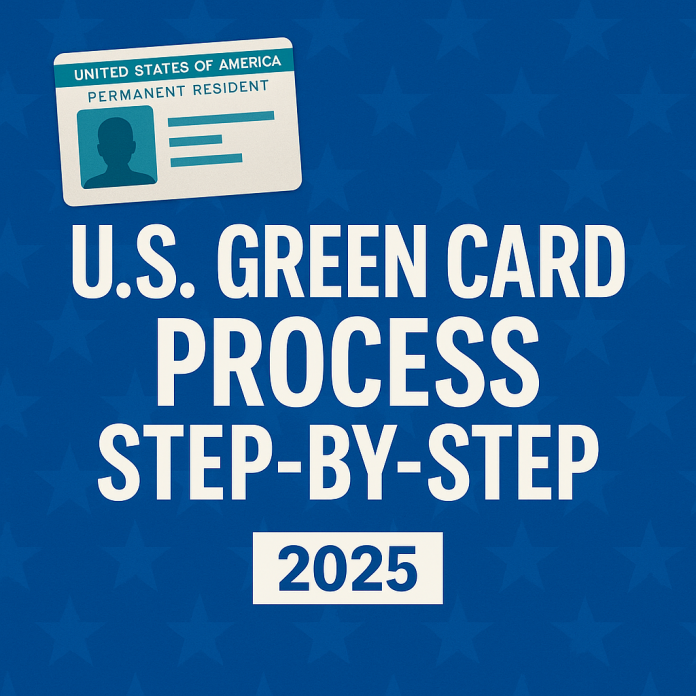Getting a U.S. Green Card officially known as Permanent Resident Status—allows you to live and work in the United States permanently. The process can look complicated, but when broken down into steps, it becomes much easier to understand.
This complete guide explains each step, the documents you need, and how the approval process works in 2025.
⭐ Step 1: Choose Your Green Card Category
There are several ways to qualify:
A. Family-Based Green Card
You can apply if you are:
-
Spouse of a U.S. citizen
-
Parent of a U.S. citizen
-
Child (unmarried or married)
-
Sibling of a U.S. citizen
This is the most common category.
B. Employment-Based Green Card
There are 5 main categories:
| Category | Who Qualifies? |
|---|---|
| EB-1 | Extraordinary ability / managers / researchers |
| EB-2 | Advanced degrees / exceptional ability |
| EB-2 NIW | National Interest Waiver (no employer needed) |
| EB-3 | Skilled workers, professionals, laborers |
| EB-5 | Investors who create U.S. jobs |
C. Diversity Visa Lottery
The U.S. runs a yearly lottery for applicants from select countries.
D. Refugee or Asylee Status
People granted asylum or refugee protection can apply after 1 year.
⭐ Step 2: Your Sponsor Files the Petition
Most green cards start with a petition filed by a family member or employer.
A. Family-Based Petition
Your relative files Form I-130.
The form proves:
-
Your relationship
-
Their U.S. citizenship or Green Card status
B. Employment-Based Petition
Your employer files Form I-140.
EB-2 NIW and EB-1A applicants can self-petition (no employer needed).
C. Visa Lottery
No petition is required. Winners go directly to the next stage.
⭐ Step 3: Wait for Priority Date to Become Current
This is one of the longest steps.
Every petition receives a Priority Date based on when it was filed.
You must wait until it becomes current in the Visa Bulletin.
Factors affecting wait time:
-
Country (India, China often wait longer)
-
Category (family vs employment)
-
Number of visas available
Some categories have no waiting time (immediate relatives).
⭐ Step 4: File Your Green Card Application
There are two ways to apply:
Option A: Apply Inside the U.S. (Adjustment of Status)
File Form I-485 if you are already in the U.S. legally.
Includes:
-
Medical exam
-
Fingerprints
-
Work permit (EAD)
-
Travel permit (Advance Parole)
Option B: Apply Outside the U.S. (Consular Processing)
If living abroad, go through a U.S. Embassy interview.
You will submit:
-
Civil documents
-
Police certificates
-
Medical examination
-
DS-260 form
⭐ Step 5: Attend Biometrics Appointment
USCIS takes your:
-
Fingerprints
-
Photo
-
Signature
This verifies your identity and checks background records.
⭐ Step 6: Attend Your Green Card Interview
This is a key step.
Interview includes:
-
Reviewing documents
-
Confirming relationship (for family cases)
-
Confirming job offer (for employment cases)
-
Background & security questions
Common questions:
-
How did you meet your spouse?
-
What job will you do in the U.S.?
-
Have you ever overstayed a visa?
-
Do you have criminal history?
Honesty and consistency are very important.
⭐ Step 7: Receive Approval (Form I-797 Notice)
If approved, you will receive:
✔ A welcome notice
✔ Your Green Card (mailed to your U.S. address)
If applying abroad, the embassy will place an immigration visa in your passport.
You become a Permanent Resident after entering the U.S.
⭐ Step 8: Green Card Validity & Renewal
A Green Card is valid for 10 years.
Renew using:
-
Form I-90, or
-
File for U.S. Citizenship after 3–5 years (depending on your category)
⭐ How Long Does the Green Card Process Take? (2025)
| Stage | Time |
|---|---|
| I-130 / I-140 petition | 6–12 months |
| Visa Bulletin waiting | 0–10 years (varies) |
| I-485 processing | 8–18 months |
| Consular processing | 6–12 months |
| Total | 1–12 years depending on category |
Employment-based and immediate relatives generally have faster timelines.
⭐ Most Common Reasons for Green Card Denials
❌ Fake marriage
❌ Missing documents
❌ Criminal record
❌ Fraud or misrepresentation
❌ Public charge issues
❌ Failed medical exam
❌ Inconsistent interview answers
⭐ Conclusion
The U.S. Green Card process requires patience and careful documentation, but breaking it into steps makes it much easier. Whether applying through family, employment, or the visa lottery, following each step correctly greatly increases your chances of success.



